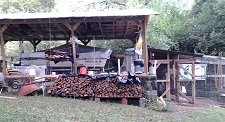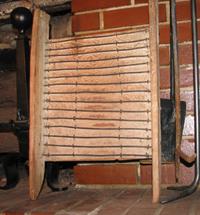Care of Redworms and European Nightcrawlers
Vermiculture: technology unlimited raising earthworms for resale, focusing on worm growth, reproduction, and health
They come packaged in dampened peat moss.
Worms may loose up to one third of their body weight during shipping, but they will quickly gain it back when introduced to their new home.
Indoor composting
Container
Almost any container that keeps worms in and offers drainage and sufficient oxygen can be used. The basic worm box size is one foot high, two feet deep and three feet wide and has air holes in the bottom. However, a variety of containers will do.
Bedding
We recommend bedding made from shredded newspaper and compost or good garden soil. Tear regular newsprint only (no colored pages) in strips approximately 11/2 inches wide. You will need about 10 pounds for the above container: Add about a gallon of compost or garden soil and mix with water. The bedding should be moistened to the “firm ball” stage. When squeezed, water droplets (not streams) will fall and when released it will form a ball. The bedding should never be so wet that water drains out of the air holes in the bottom of the bin. Redworms and European Nightcrawlers are surface feeders and only the top six inches or so needs to be damp. Ideally the bottom of the bin can be bone dry.
***Salt kills worms***
Spread your worms and the bedding they came in over the moistened bedding. The worms should disappear into the bedding in 10-15 minutes. Both species of worms will have a tendency to try to crawl when first put into a new bin or bed. You will need to either put a tight fitting vented lid on your bin or keep a light o over them to prevent them from escaping. The Redworms will usually settle down within a few days but the European Nightcrawlers will crawl at any time, for no apparent reason. The European Nightcrawlers should either always be covered with a lid that allows adequate air flow or a light should be kept on over them.
It is normal to have worms crawling up the sides and getting under the lid of a plastic bin. The like to be in the condensation that forms in these bins. If you want to get them to go back into the bedding, remove the lid, tap on the lid to get them back onto the bedding. Make sure there is a light on over the bin. Once the sides and top of the bin dry out the worms will burrow back into the bedding.
Food
The worms will consume any kind of biodegradable matter, except materials containing excess oil or chemicals.
Suggested- fruits, vegetables, coffee grounds, tea bags, eggshells, and any vegetable matter.
No- meat, bones, salt, vinegar, cooking oils and dairy products.
A 12-14 gallon worm bin will hold about six pounds of organic waste per week but we recommend starting more slowly. To encourage decomposition, you may want to finely chop the material before adding it to the bin.
Harvesting
Your worm bin should be ready to harvest in about two to three months (60 – 90 days).
Window Screen Sort
When it’s nearly time to harvest, set a window screen (Cut 6” wider than the bin all around) over the composting mass. Then place fresh bedding on top of the screen and feed on top of this second layer. The worms will squeeze through as food runs out below and the food above attracts them. After a few months, take hold of the screen edges and life it out. Harvest the finished material you find below, then dump the newer composting material onto the bottom of the bin and replace the screen.
Outdoor Composting
Redworms can also be used in an outdoor compost pile. If possible, release the worms in the morning. This will give them time to settle into their new environment before dark and help to prevent crawling. Simply dig a shallow hole in the pile; spread the worms along with the bedding they came with into the hole and cover. The worms will naturally seek out an area of the pile that is the right temperature. During cold months, they will migrate into the center where the temperature is generally warmer and in warm months they will migrate to the outside.
your inner voice.com and Vermitechnology Unlimited















